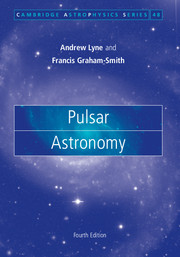Book contents
- Frontmatter
- Contents
- List of illustrations
- Preface
- 1 The discovery of pulsars
- 2 Neutron stars
- 3 Telescopes and techniques
- 4 The distances of the pulsars
- 5 Pulsar timing
- 6 Timing and astrometry of binary pulsars
- 7 Timing irregularities
- 8 The Galactic population of pulsars
- 9 The Crab and Vela Pulsars
- 10 Other young pulsars
- 11 Millisecond and binary pulsars
- 12 Accretion-powered X-ray pulsars
- 13 Magnetars
- 14 Supernovae and their remnants
- 15 Integrated pulse profiles
- 16 Individual pulses
- 17 Location of emitting regions
- 18 Radiation processes
- 19 The emission mechanisms
- 20 Interstellar scintillation and scattering
- 21 The interstellar magnetic field
- 22 Achievements and prospects
- References
- Index
20 Interstellar scintillation and scattering
Published online by Cambridge University Press: 05 March 2012
- Frontmatter
- Contents
- List of illustrations
- Preface
- 1 The discovery of pulsars
- 2 Neutron stars
- 3 Telescopes and techniques
- 4 The distances of the pulsars
- 5 Pulsar timing
- 6 Timing and astrometry of binary pulsars
- 7 Timing irregularities
- 8 The Galactic population of pulsars
- 9 The Crab and Vela Pulsars
- 10 Other young pulsars
- 11 Millisecond and binary pulsars
- 12 Accretion-powered X-ray pulsars
- 13 Magnetars
- 14 Supernovae and their remnants
- 15 Integrated pulse profiles
- 16 Individual pulses
- 17 Location of emitting regions
- 18 Radiation processes
- 19 The emission mechanisms
- 20 Interstellar scintillation and scattering
- 21 The interstellar magnetic field
- 22 Achievements and prospects
- References
- Index
Summary
Optical scintillation is familiar as the twinkling of stars, and as the shimmer of distant objects seen through a heat haze. At radio wavelengths scintillation is encountered in many different circumstances, because there are many kinds of radio transmission paths which contain the necessary phase irregularities: the solar corona, for example, contains an irregular outflowing gas, which disturbs radio waves passing through it from distant objects to the Earth. The effects of this may be thought of either as refraction or as diffraction; in more general terms the waves are scattered, giving rise to an angular spread of waves and to subsequent fluctuations in wave amplitude, which are seen as intensity variations as the Earth moves relative to a pattern of irregularities. Similar effects are observed in the passage of radio waves through the Earth's ionosphere.
At the time of discovery of pulsars, the known examples of radio scintillation gave a rapid fading pattern, not very different from the visible twinkling stars. The comparatively slow, deep fading of radio signals from the pulsars was an entirely new phenomenon, which was first recognised as a form of scintillation by Lyne & Rickett (1968). The basic analysis of scintillation in terms of random refraction in the interstellar medium was presented by Scheuer (1968). He showed that the fluctuations should have a fairly narrow frequency structure, whose width should depend on the distance of the pulsar.
- Type
- Chapter
- Information
- Pulsar Astronomy , pp. 279 - 299Publisher: Cambridge University PressPrint publication year: 2012

